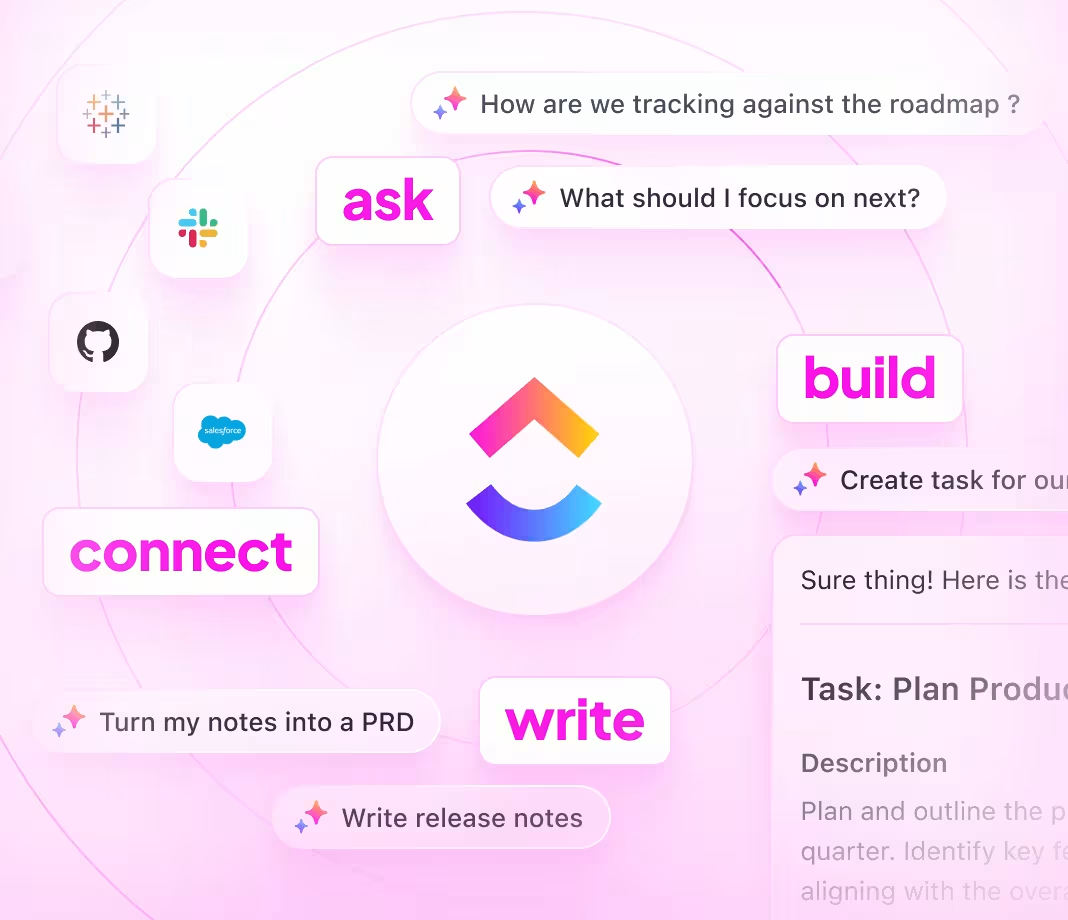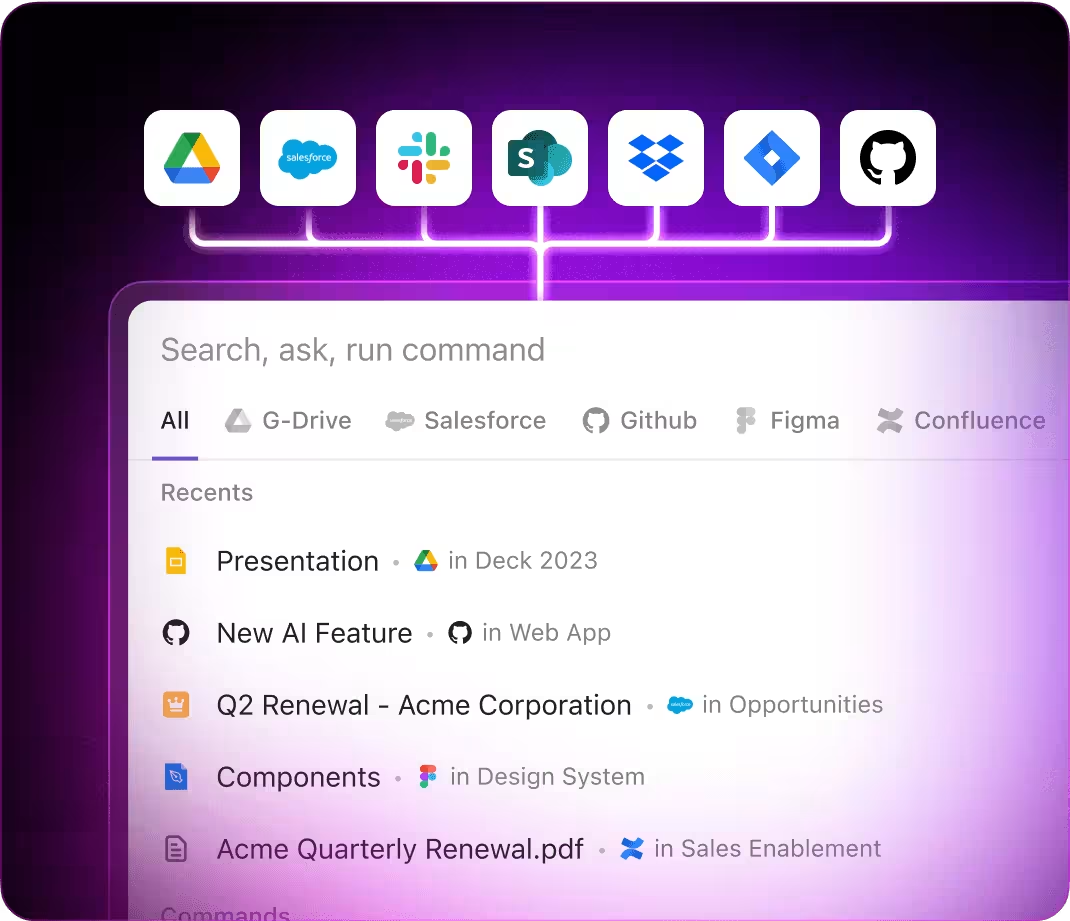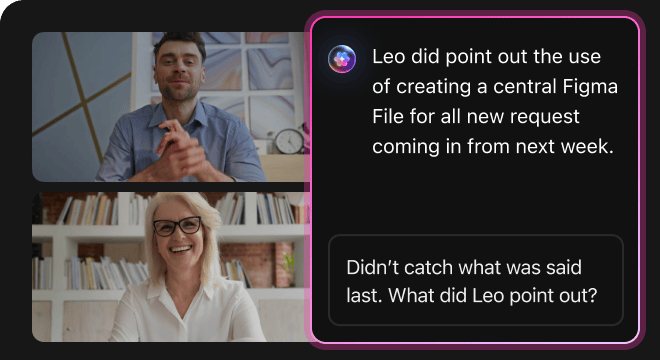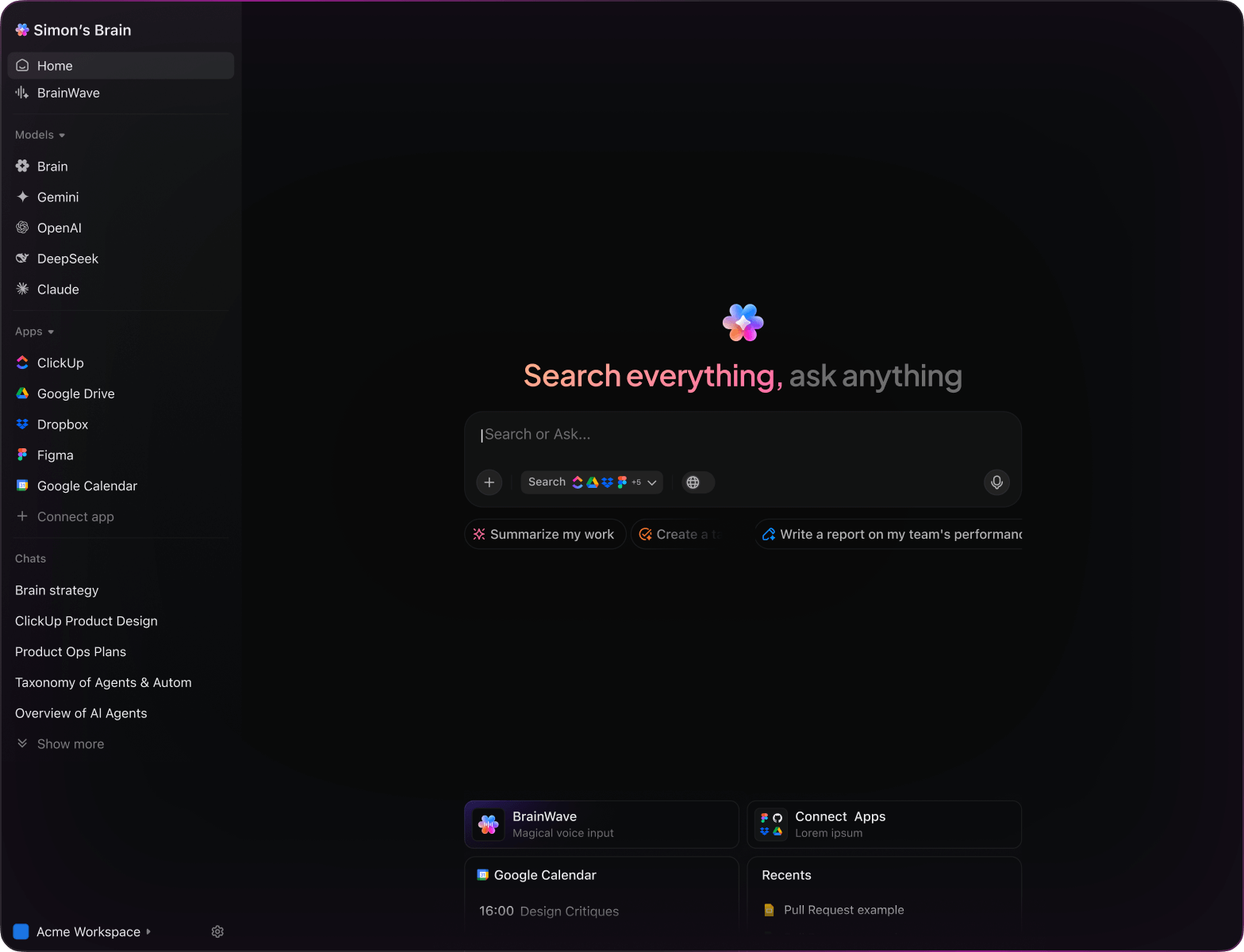AI-Powered UX Research
Top AI Prompts for UX Research with ClickUp Brain
Enhance user insights, simplify research processes, and elevate your UX projects using ClickUp Brain’s intelligent assistance.

Trusted by the world’s leading businesses
AI Empowering UX Research
Revolutionizing UX Research with AI-Driven Prompts
Crafting exceptional user experiences demands more than just intuition—it requires deep insights and organized workflows.
UX research spans user interviews, usability testing, data analysis, and reporting, involving countless notes, findings, and iterations. AI prompts are now pivotal in managing this complexity.
UX teams leverage AI to:
- Quickly identify user behavior patterns and pain points
- Generate research plans, interview questions, and test scripts effortlessly
- Distill lengthy user feedback into concise summaries
- Transform raw data into clear reports, personas, or actionable tasks
Integrated within familiar tools like documents, boards, and task trackers, AI in ClickUp Brain doesn’t just assist—it actively shapes your research process into a streamlined, impactful journey.
Comparing ClickUp Brain with Conventional AI
Why ClickUp Brain Stands Out
ClickUp Brain integrates seamlessly, understands your context, and empowers you to focus on research, not explanations.
Conventional AI Solutions
- Constantly switching apps to collect project details
- Repeating your research objectives in every query
- Receiving generic, irrelevant feedback
- Hunting through multiple platforms for a single insight
- Interacting with AI that lacks proactive engagement
- Manually toggling between different AI models
- Merely an add-on in your browser
ClickUp Brain
- Fully synchronized with your UX tasks, notes, and team communications
- Retains your research history and objectives
- Delivers context-aware, practical guidance
- Centralized search across all your UX resources
- Voice-enabled commands with Talk to Text
- Automatically selects the optimal AI model: GPT, Claude, Gemini
- Dedicated desktop app for Mac & Windows—optimized for performance
AI Prompts for UX Research
15 Essential AI Prompts for UX Research with ClickUp Brain
Enhance your UX research process—insights, analysis, and user understanding simplified.

Identify 5 key UX themes for a mobile app revamp based on the ‘User Feedback Q1’ document.
ClickUp Brain Behavior: Analyzes user comments and research notes to highlight prominent experience patterns and improvement areas.

Summarize usability trends in health tracking apps under $50, referencing internal market research and competitor analysis.
ClickUp Brain Behavior: Integrates findings from research files; Brain Max can supplement with relevant public data when accessible.

Create a research brief focused on enhancing accessibility, drawing from ‘Accessibility Audit’ notes and prior user interviews.
ClickUp Brain Behavior: Extracts critical insights and user needs from linked documents to compose a structured research plan.

Summarize navigation design differences between App A and App B using our ‘Navigation Study’ document.
ClickUp Brain Behavior: Pulls comparative data and user feedback from internal sources to generate a concise overview.

Identify leading interaction design features preferred by Gen Z, referencing survey data and UX reports.
ClickUp Brain Behavior: Reviews internal documents to compile a list of favored UI components and interaction styles.

From the ‘Onboarding Flow Analysis’ doc, create a checklist for usability testing criteria.
ClickUp Brain Behavior: Extracts key evaluation points and formats them into a practical testing guide within a task or document.

Highlight three recent trends in voice UI design from post-2023 research and technology review documents.
ClickUp Brain Behavior: Identifies recurring themes and innovations from linked research materials.

From the ‘Dark Mode User Survey’ doc, extract main preferences and concerns regarding dark mode usage.
ClickUp Brain Behavior: Analyzes survey responses to reveal common design preferences and usability feedback.

Craft clear and engaging UX text for a privacy settings interface using tone guidelines from ‘BrandVoice.pdf’.
ClickUp Brain Behavior: References tone documents to suggest copy variations aligned with brand personality.

Outline major GDPR changes for 2024 and their implications on user interface elements.
ClickUp Brain Behavior: Reviews compliance documents and summarizes critical points impacting design choices.

Develop placement and sizing guidelines for form fields on mobile devices, referencing usability standards in our workspace.
ClickUp Brain Behavior: Extracts best practices and rules from internal documents to form a comprehensive guideline checklist.

Using WCAG 2.2 PDFs and our project files, generate a checklist for accessibility testing across digital products.
ClickUp Brain Behavior: Identifies criteria from standards documents and organizes them into actionable testing tasks.

Summarize engagement strategies like notifications and feedback loops in leading social apps using competitive analysis docs.
ClickUp Brain Behavior: Synthesizes documented comparisons into an easy-to-read summary or table format.

Identify emerging user interface trends in wearable technology from recent research notes and market reports.
ClickUp Brain Behavior: Collates trend data from internal documents and uploaded studies to highlight key developments.

Extract and prioritize usability issues reported during remote testing sessions, focusing on navigation and interaction.
ClickUp Brain Behavior: Analyzes feedback notes, survey data, and tagged tickets to identify critical user pain points.
Elevate UX Research with ClickUp Brain
Cut down on revisions, unify your team’s insights, and produce superior research outcomes using AI-driven workflows.






LLMs vs. Workflow Intelligence: How ClickUp Brain Enhances UX Research
Discover How ChatGPT, Gemini, Perplexity, and ClickUp Brain Tackle UX Research Challenges
ChatGPT UX Research Prompts
- Condense these user interview notes into a 5-point summary focusing on pain points and needs.
- Draft a user persona profile highlighting motivations, frustrations, and goals.
- Generate 3 alternative wireframe concepts for a mobile app onboarding flow emphasizing ease of use.
- Outline a step-by-step usability testing plan for a new feature prototype.
- Compare feedback from last 3 usability sessions and summarize key improvement areas.
Gemini UX Research Prompts
- Create 3 alternative user journey maps for an e-commerce checkout process based on survey data.
- List innovative interaction design ideas focusing on accessibility and inclusivity.
- Produce a mood board description for a health app interface highlighting colors, typography, and imagery.
- Suggest layout options for a dashboard targeting data analysts and rank by clarity and efficiency.
- Develop a comparison table of three user feedback tools focusing on features, ease of integration, and reporting capabilities.
Perplexity UX Research Prompts
- List 5 emerging UX research methods and rank them by applicability to remote teams.
- Provide a comparison of prototyping tools highlighting collaboration features and learning curve.
- Summarize recent trends in user behavior analytics and their impact on design decisions.
- Generate a list of 5 effective survey question types for product satisfaction and rank by response rate.
- Compare past UX case studies and summarize top 3 takeaways for improving user engagement.
ClickUp Brain UX Research Prompts
- Transform this user feedback log into prioritized UX research tasks with assigned owners.
- Summarize stakeholder meeting notes and create follow-up action items with deadlines.
- Analyze annotated wireframes and generate a checklist for design revisions and validations.
- Compile a task list from cross-functional discussions on interface improvements, including priority tags.
- Summarize usability test transcripts and create actionable design and development tasks within ClickUp.
Why Choose ClickUp
Transform Early Ideas Into Polished UX Plans
- Quickly convert scattered research notes into detailed UX documentation.
- Generate innovative concepts by analyzing previous user feedback.
- Build customizable templates to accelerate your design cycles.
Brain Max Boost: Effortlessly explore historical user studies, prototypes, and team comments to fuel your upcoming UX strategies.

Why Choose ClickUp
Accelerate UX Research Insights Delivery
- Break down detailed user feedback into concise, actionable tasks.
- Transform research observations into assignable project items effortlessly.
- Automatically compile findings and summaries without extra effort.
Brain Max Boost: Instantly access historical study data, user segment analyses, or prototype iterations across your research projects.

AI Advantages
How AI Prompts Elevate Every Phase of UX Research
AI prompts accelerate insights and inspire more user-centered, impactful research.
Quickly Develop Research Hypotheses
Researchers explore diverse user scenarios rapidly, refine questions effectively, and avoid analysis paralysis.
Enhance Data-Driven Insights
Make informed interpretations, reduce bias, and craft findings that resonate with users and stakeholders alike.
Identify Flaws Early in the Process
Prevents expensive missteps in later stages, improves study accuracy, and shortens feedback cycles.
Align Teams with Clear Research Goals
Strengthens collaboration, removes confusion, and accelerates consensus among UX, product, and design teams.
Drive User-Centered Innovation
Ignites creative solutions, uncovers unmet needs, and keeps your products ahead in user experience.
Integrated AI Support Within ClickUp
Transforms AI-generated insights into actionable tasks that propel your research projects forward.
Speed Up Your UX Design Cycle
Cut down mistakes, simplify collaboration, and generate insightful results with AI-powered support.





